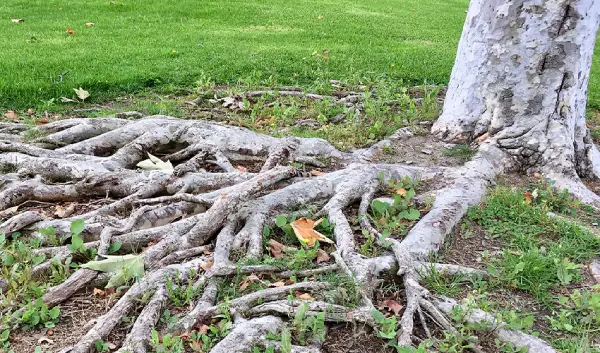
The Grounds Guys provides a guide on managing exposed tree roots effectively.
|
If you have trees on your property, you know what a benefit they are. They help shade your home and property, prevent soil erosion, and add curb appeal to your home. And while trees are a welcoming addition to your landscape, they can present challenges as they grow larger. In some cases, when tree roots become exposed, they can cause problems in addition to not looking very nice. Exposed tree roots can destroy lawn mower blades, buckle sidewalks, and damage irrigation.
If you want to know what to do with tree roots above ground, we can help. There are ways to deal with exposed tree roots that can help reduce the risks of damage and improve how they look. The experts at The Grounds Guys® have some advice that will help you manage exposed tree roots. But first, let’s get to the root of this problem.
Table of Contents:
- What Causes Tree Roots to Become Exposed?
- What Are the Consequences of Leaving Exposed Roots Untreated?
- What Are Some Effective Techniques for Fixing Exposed Tree Roots?
- Add a Layer of Mulch
- Add Ground Cover (Just Not Grass)
- Don’t Add More Soil
- Don’t Grow New Grass
- Don’t Remove Exposed Tree Root
- Can I Prevent Tree Roots from Becoming Exposed?
What Causes Tree Roots to Become Exposed?
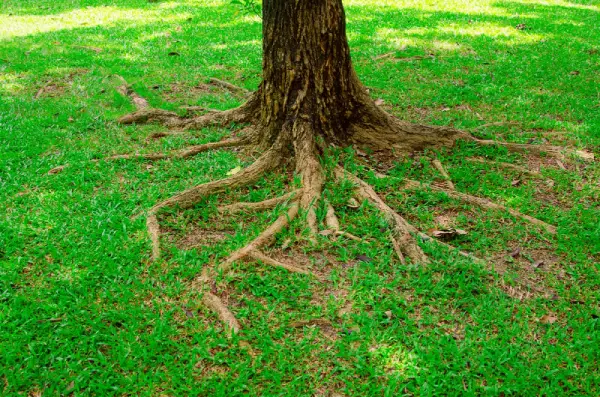
Mature trees are fantastic additions to landscapes, especially those that provide shade during hot and sunny days. But those big shade trees we love can develop surface roots that cause various issues. Is there a reason why these roots break the surface instead of remaining underground? There are several reasons why your tree has exposed roots. Roots can be exposed due to the following:
The tree’s roots get thicker every year, just like the trunk. As the roots expand and grow, they sometimes breach the surface of the ground.
The soil around the roots is eroding. Erosion can be caused by rain, runoff, or wind.
The tree doesn’t have enough space for its root system to expand. When roots have nowhere else to go, they will eventually break the surface. Trees confined to small areas near sidewalks, fences, buildings, or streets, are more likely to expand upward.
What Are the Consequences of Leaving Exposed Roots Untreated?

When exposed tree roots are left untreated, they can pose hazards to the tree and you. Potential issues arising from a tree with exposed roots include the following:
The risk of disease, rot, and insect infestation are increased. Sidewalks, driveways, and foundations can be damaged and cause injury. Severe damage to landscape equipment that comes in contact with exposed roots.
Roots that emerge from walkways and driveways create a serious trip hazard. When exposed tree roots become infected and are left untreated, the tree could die. Dead trees can topple over when there are strong winds, and during dry conditions, they can catch fire.
What Are Some Effective Techniques for Fixing Exposed Tree Roots?
So, what should you do with tree roots above the ground? You might think that simply cutting the tree roots away is the best solution. However, cutting away roots does more damage than good, as it leaves the tree susceptible to disease and infestations. The following tips will help keep the situation under control:
Add a Layer of Mulch
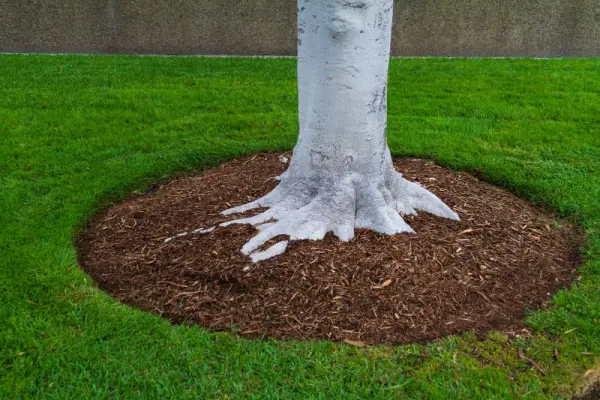
Adding a mulch layer is both the preferred and the easiest option when it comes to dealing with exposed tree roots. Carefully remove the remaining grass around the base of the tree and replace it with a thick layer of mulch. This will cushion and insulate the roots, discourage pedestrian traffic, and eliminate the need for mowing. Use shredded or chipped hardwood bark for mulch, but avoid the stained variety, as these may contain harmful dyes that can damage tree roots.
Add Ground Cover (Just Not Grass)
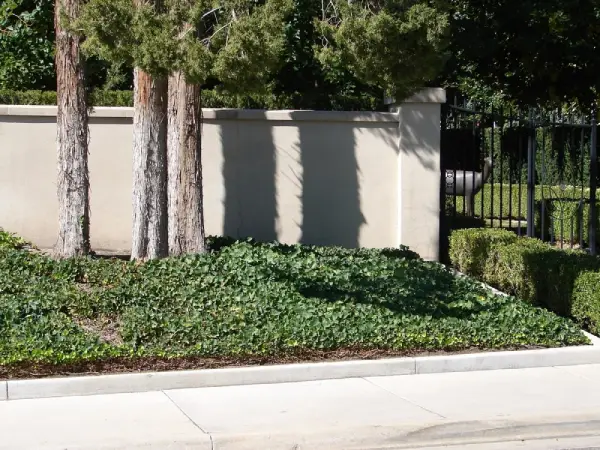
Another option is to replace the grass with a ground cover that will not require mowing. Choose a taller ground cover when possible to help discourage foot traffic in the area. When planting the new ground cover, ensure that you don’t harm the major tree roots in the process.
Don’t Add More Soil
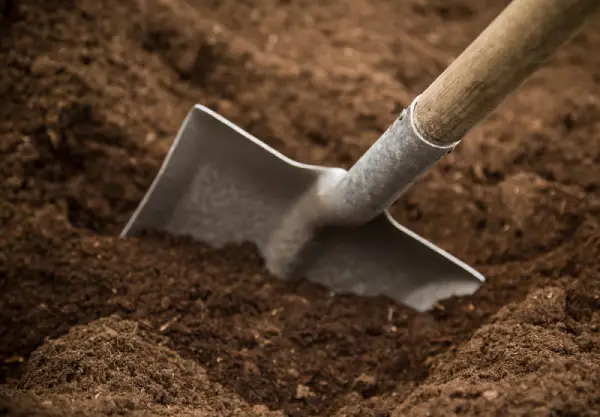
To reverse the effects of erosion, you may be tempted to add more soil around the base of the tree, covering up the exposed roots. While this solution may provide temporary relief, it can cause further damage over time by suffocating the roots or failing to resolve the underlying issue. Adding mulch or ground cover is a much better long-term solution to address your exposed roots.
Don’t Grow New Grass

While it is possible to cultivate a new layer of grass, it can take time to become established, and eventually, the roots may reappear. If a lack of sunlight is the issue, the new grass may also die, and the roots may soon reappear.
Don’t Remove Exposed Tree Root
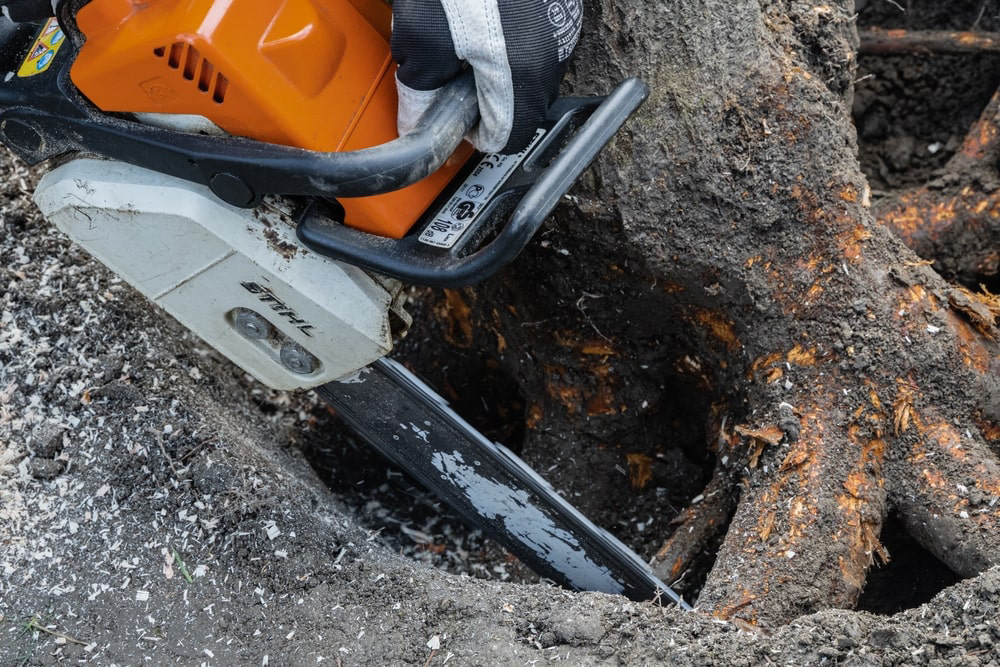
Cutting or pruning tree roots is a risky venture that can injure or kill the tree if done incorrectly. In addition to depriving the tree of nutrients and water, improper pruning may render the tree unstable, causing it to fall over in a storm.
Can I Prevent Tree Roots from Becoming Exposed?
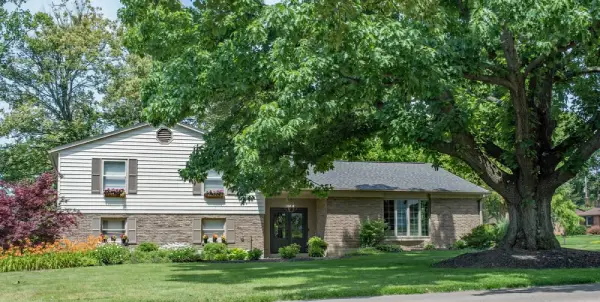
Knowing how to fix exposed tree roots is certainly helpful, but if you can avoid having a tree with exposed roots that’s even better. If you’re planting new trees on your property, here are a few simple steps you can take to avoid exposed tree roots down the road:
Choose an optimal planting location that is best suited for the tree species. Trees like oaks and maples grow large and therefore have extensive root systems. Make sure they are planted in areas that provide ample space to grow and thrive.
Soil type, moisture level, nutrients, and the soil's pH level affect how tree roots grow, so learn about what your tree(s) needs for optimal growth. Select a tree species that isn't prone to grow exposed roots. If you're unsure, contact The Grounds Guys nearest you. Our experts will be happy to answer any questions.
Save Your Trees and Property: Fix Exposed Roots Now
Mature trees are beautiful. They benefit your community, your property, and the environment. Healthy trees bring happiness and joy and improve the curb appeal of a neighborhood. But when tree roots are exposed, it can jeopardize the health of the tree and create a hazard for the community. That’s why it is important to take steps now to fix exposed roots so they don’t create unnecessary problems for your tree and property.
If you have tree roots that are buckling concrete or have become a safety hazard, contact a local professional. Our team of experienced pros will assess the situation and let you know if the entire tree should be removed or if some roots can be removed without damaging the tree. Our tree maintenance services will help you figure out what to do about exposed tree roots. We have the training and expertise to get the job done right and stand behind all our work with the Neighborly Done Right Promise™, which ensures your satisfaction.
Contact The Grounds Guys to request an estimate today.
FAQs About Exposed Tree Roots
Our 200 franchise locations across the U.S. and Canada share a common goal - use our years of experience and expertise to help you bring the vision for their property to life. This includes answering questions you have about landscaping and lawn care. Below are answers to some of the most frequently asked questions about tree roots above the ground.
What causes tree roots to become exposed above ground?
Tree roots become exposed above ground due to several natural and environmental factors. The primary cause is the natural growth pattern of the tree itself. As trees mature, their roots expand and thicken annually, eventually pushing through the soil surface. Soil erosion from heavy rainfall, irrigation runoff, or wind also exposes roots by washing away the protective soil layer around them.
Different tree species have varying root growth patterns that can affect whether the roots become exposed. Pine tree roots, for example, tend to grow more horizontally and closer to the surface compared to trees with deeper root systems. This shallow growth pattern makes pine trees particularly susceptible to root exposure as they mature.
Space constraints force roots upward when there's nowhere else to expand. Trees planted too close to sidewalks, driveways, buildings, or other structures often develop exposed roots because their natural growth space is limited. Additionally, compacted soil from foot traffic or heavy machinery can prevent roots from penetrating deeper, causing them to spread horizontally near the surface instead.
Is it okay to cover exposed roots with soil or grass?
No, covering exposed tree roots with additional soil is not recommended and can actually harm your tree. Adding soil over exposed roots creates several problems that can compromise tree health and may not solve the underlying issue.
Why adding soil to cover exposed tree roots backfires:
- Suffocates the roots by reducing oxygen flow, which trees need to survive
- Changes the soil grade around the tree, potentially causing water to pool against the trunk
- Creates an environment that promotes root rot and fungal diseases
- May kill beneficial soil organisms that help trees absorb nutrients
While you might successfully establish grass over covered roots initially, the roots will likely re-emerge as they continue growing. Pine tree roots and other shallow-rooted species are especially prone to breaking through new soil layers. The grass may also struggle to thrive due to competition from tree roots for water and nutrients, plus reduced sunlight under the tree canopy.
Instead of adding soil, focus on protective measures like mulching or installing appropriate ground cover that works with the tree's natural growth pattern rather than against it.
What’s the safest way to protect exposed tree roots without harming the tree?
The safest approach to protecting your tree and roots involves working with the tree's natural growth pattern rather than fighting it. Organic mulch application is the most effective and tree-friendly solution.
Best protection methods:
Apply quality mulch: Use 2-4 inches of organic mulch like shredded hardwood bark around the exposed roots, extending to the tree's drip line. This insulates roots from temperature extremes, retains soil moisture, and prevents mechanical damage from foot traffic or lawn equipment.
Install strategic barriers: Create physical boundaries using decorative stones, low fencing, or planted borders to redirect foot traffic away from sensitive root areas. This protects both the tree and prevents trip hazards.
Choose compatible ground cover: Select shade-tolerant, shallow-rooted plants that won't compete aggressively with tree roots. Hostas, ferns, or native woodland plants work well under most trees, including around pine tree roots.
Avoid these harmful practices:
- Never cut or remove exposed roots unless absolutely necessary
- Don't use rubber mulch or landscape fabric, which can trap moisture and create problems
- Avoid planting grass directly over root zones
For trees with roots causing structural damage to walkways or foundations, consult with certified arborists who can assess whether selective root pruning is possible without compromising tree stability and health.
This article is intended for general informational purposes only and may not be applicable to every situation. You are responsible for determining the proper course of action for your home and property. The Grounds Guys are not responsible for any damages that occur as a result of this blog content or your actions. For the most accurate guidance, contact The Grounds Guys location nearest you for a comprehensive, on-site assessment.